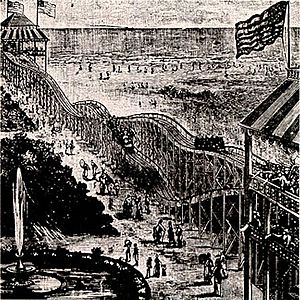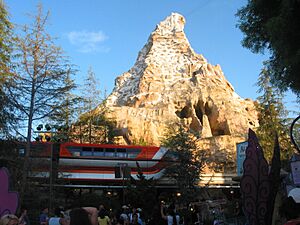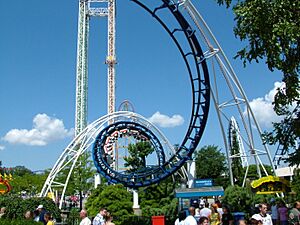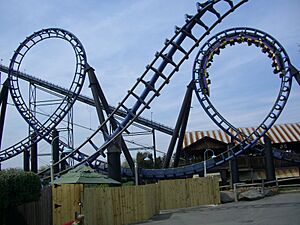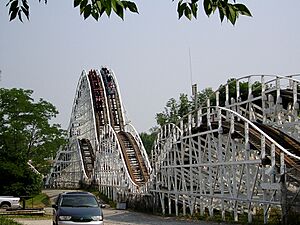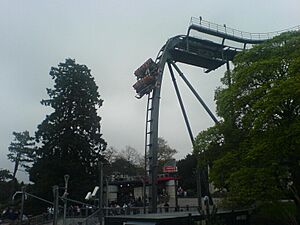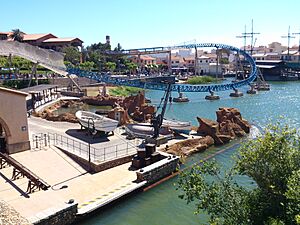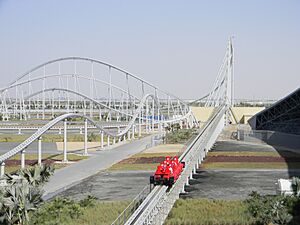History of the roller coaster facts for kids
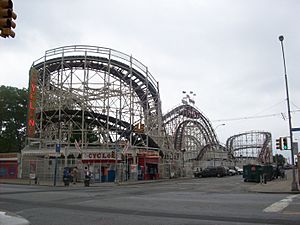
Roller coasters are exciting amusement rides that have a long history. They started with simple ice slides in Russia in the 1700s. Back then, people used sleds or carts on wheels to slide down hills of snow. These hills were often supported by wood. Over time, this idea grew into rides with railroad tracks and cars that stayed safely on the rails. By the early 1900s, new ways of building tracks allowed for faster speeds and sharper turns. Later, steel designs made it possible for riders to go upside down!
Contents
The Exciting History of Roller Coasters
How Roller Coasters Began
The very first roller coasters came from "Russian Mountains" in the 1600s. These were big hills made of ice built in the gardens of palaces around Saint Petersburg, Russia. People would slide down them for fun! Even today, some languages, like Spanish and French, still call roller coasters "Russian mountains." But in Russian, they call them "American mountains."
These fun slides were called Katalnaya Gorka, meaning "sliding mountain." Many were about 70 to 80 feet (21 to 24 meters) tall with a steep 50-degree drop. They were popular with rich Russians. In 1784, Catherine the Great built a summer version of the ride. It used wheeled carts instead of sleds, running on special grooved tracks.

After Napoleon's defeat in 1815, Russian soldiers in Paris might have shared the idea of sliding down hills. In 1817, a French banker named Nicolas Beaujon opened an amusement park in Paris. His most famous ride was the Promenades Aériennes, or "Aerial Strolls." It had wheeled cars that were securely locked to the track. Guide rails kept them on course, allowing for faster speeds. Soon, seven similar rides opened in Paris.
At first, these rides were mostly for wealthy people. But in 1845, Tivoli Gardens opened in Copenhagen, Denmark, for everyone. These new parks made roller coasters a main attraction. The first permanent loop was likely built in Paris in 1846. It was a 13-foot (4 meter) tall vertical loop for a single sled. These early looping rides were called Centrifugal Railways. Later, in 1887, a French businessman built a permanent roller coaster with a double-eight shape, which was later made even bigger.
The Rise of Scenic Railways
In the 1850s, a mining company in Summit Hill, Pennsylvania, built a special gravity railroad. It was an 8.7-mile (14 km) downhill track used to carry coal. By 1872, people could buy tickets to ride this "Gravity Road" just for fun! Other railway companies also started offering rides on their tracks when they weren't busy.
Using this idea, LaMarcus Adna Thompson built a gravity Switchback Railway at Coney Island in Brooklyn, New York in 1884. Riders would climb a platform, then ride a car down a 600-foot (183 meter) track to another tower. The car would then switch tracks for the return trip. Soon, this design was replaced with a full oval track. In 1885, Phillip Hinkle created the first full-circle coaster with a lift hill, called the Gravity Pleasure Road. It became very popular at Coney Island. In 1886, LaMarcus Adna Thompson patented his own roller coaster design. It included dark tunnels with painted scenes. These "Scenic Railways" soon appeared in parks everywhere.
Growing Popularity and New Ideas
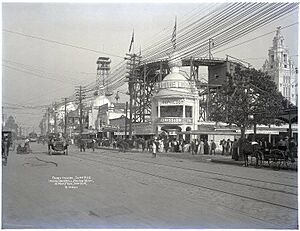
As roller coasters became more popular, people started trying new things. In the 1880s, the idea of a vertical loop came back. In 1895, the Flip Flap Railway opened in Brooklyn with a loop. Soon after, similar coasters like Loop the Loop appeared. However, these rides were very dangerous, and many riders got whiplash. They were quickly taken down. It would be over 50 years before looping coasters returned safely.
By 1919, John Miller developed the first underfriction roller coaster. This made rides safer and more exciting. Soon, roller coasters spread to amusement parks worldwide. One of the most famous old roller coasters, The Cyclone, opened at Coney Island in 1927. All early roller coasters were made of wood. Many old wooden roller coasters are still running today. For example, Leap-The-Dips in Pennsylvania was built in 1902 and is the oldest operating roller coaster. The Scenic Railway at Dreamland in the United Kingdom is the oldest wooden coaster there. It even has a brakeman who rides in the car! The Scenic Railway at Melbourne's Luna Park in Australia, built in 1912, is the world's oldest roller coaster that has been running non-stop.
The Great Depression in the 1930s caused amusement parks to decline. This meant fewer new roller coasters were built. This slowdown lasted until 1972. That year, The Racer opened at Kings Island in Ohio. It was designed by John C. Allen. The Racer's huge success brought back interest in roller coasters around the world.
The Rise of Steel Roller Coasters
In 1959, Disneyland introduced a major new idea with the Matterhorn Bobsleds. This was the first roller coaster to use a tubular steel track. Unlike wooden tracks, which are flat, tubular steel can be bent in any direction. This allowed designers to add loops, corkscrews, and other cool moves. Most modern roller coasters are made of steel. However, new wooden coasters and even "hybrid" coasters (made of both steel and wood) are still being built.
In 1975, the first modern roller coaster with an upside-down part opened. It was Corkscrew at Knott's Berry Farm in California. In 1976, the vertical loop made a permanent comeback with the Great American Revolution at Six Flags Magic Mountain in California.
Timeline of Important Roller Coasters
This timeline highlights roller coasters that were important for different reasons. They might have been the first of their kind, set a new record, or had a big impact on the amusement park world.
18th Century Milestones
1750s
- Bartolomeo Francesco Rastrelli builds a fancy summer and winter roller coaster palace, Riding Mountain, for Russian Empress Catherine the Great. It had two tracks, one straight with five hills and one spiral. In summer, they used cars on wheels.
1784
- Catherine the Great builds a summer version of the "Russian mountain" slide. It uses sleds with wheels near St. Petersburg.
1800 to 1899 Milestones
1817
- Les Montagnes Russes à Belleville in Paris, France, is the first roller coaster with cars that lock onto the track.
- It is also the first roller coaster to have two cars racing each other.
- The Promenades Aériennes (The Aerial Walk) in Paris is the first complete-circuit roller coaster.
1827
- The Mauch Chunk Switchback Gravity Railroad in Jim Thorpe, Pennsylvania, United States, opens. This scenic gravity railroad inspired the first American roller coasters.
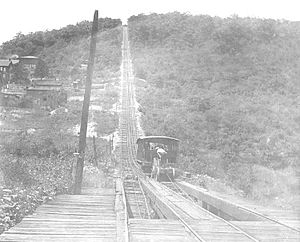
1846
- The Centrifugal Railway in Paris is the first looping roller coaster, though it wasn't a full circuit.
1885
- The Gravity Pleasure at Coney Island, Brooklyn, New York, is the first to use a powered chainlift to pull cars up a hill.
1900 to 1970 Milestones
1902
- Leap-The-Dips opens at Lakemont Park, Altoona, Pennsylvania. It is now the world's oldest operating wooden roller coaster.
- The Cannon Coaster at Coney Island tries to make cars jump over a gap in the track, but it's too dangerous and the idea is stopped.
1907
- The Drop the Dip at Coney Island is the first to use a lap bar for safety.
1909
- Virginia Reel at Luna Park, Coney Island opens as the world's first spinning roller coaster.
1912

- Scenic Railway opens at Luna Park, Melbourne, Australia. It is the world's oldest roller coaster that has been running non-stop since it opened.
1920
- Jack Rabbit at SeaBreeze, New York, is the first roller coaster to use up-stop wheels. These wheels keep the car from lifting off the track.
1925
- Cyclone at Revere Beach, Massachusetts, is the first roller coaster to reach 100 feet (30 meters) tall.
1928
- Montaña Suiza opens in Spain. It is the world's oldest operating steel roller coaster.
1959
- Matterhorn Bobsleds at Disneyland, Anaheim, California, United States, opens. It is the world's oldest operating tubular steel roller coaster.
1966
- Mine Train at Six Flags Over Texas is the first roller coaster to feature an underwater tunnel.
1970s Milestones
1972
- Fire In The Hole at Silver Dollar City, Branson, Missouri, United States, is the first enclosed roller coaster.
1975
- Corkscrew at Knott's Berry Farm, Buena Park, California, is the first "modern" roller coaster with two upside-down sections.
1976
- Revolution at Six Flags Magic Mountain, California, is the first "modern" roller coaster with a vertical loop.
- Corkscrew at Cedar Point, Sandusky, Ohio, United States, is the first roller coaster with three upside-down sections.
1978
- Loch Ness Monster at Busch Gardens Williamsburg, Williamsburg, Virginia, United States, is the first roller coaster with interlocking loops.
- Montezooma's Revenge at Knott's Berry Farm is the first roller coaster to use a flywheel launch system. It was also the tallest roller coaster when it opened.
1979
- The Beast opens. It was the tallest, fastest, and longest wooden roller coaster. Today, it is still the longest wooden roller coaster in the world.
1980s Milestones
1980
- Carolina Cyclone at Carowinds, North Carolina and South Carolina, United States, is the first roller coaster with four upside-down sections.
1982
- Viper at Darien Lake, New York, is the first roller coaster with five upside-down sections.
- Racer at Kings Island is the first roller coaster to run vehicles backward.
1983
- Moonsault Scramble at Fuji-Q Highland, Japan, is the first roller coaster to go over 200 feet (61 meters) tall. It also had the most G-force ever on a roller coaster (6.2 G's).
1987
- Vortex at Kings Island is the first roller coaster with six upside-down sections.
1988
- Shockwave at Six Flags Great America, Gurnee, Illinois, United States, is the first roller coaster with seven upside-down sections.
1989
- Magnum XL-200 at Cedar Point is the first full-circuit roller coaster to be over 200 feet (61 meters) tall.
1990s Milestones
1992
- Batman: The Ride at Six Flags Great America is the first inverted roller coaster. On this type of coaster, riders hang below the track.
1995
- Dragon Khan at PortAventura Park, Spain, is the first roller coaster with eight upside-down sections.
1996
- Flight of Fear at both Kings Island and Kings Dominion are the first roller coasters to use a linear motor (electromagnetic) launch system.
1997
- Tower of Terror II at Dreamworld, Australia, is the first roller coaster to reach 100 mph (161 km/h).
- Superman: Escape From Krypton at Six Flags Magic Mountain, California, is the first roller coaster (not a full circuit) over 400 feet (122 meters) tall.
1998
- Oblivion at Alton Towers, United Kingdom, is the first dive coaster. These coasters hold riders over a vertical drop before releasing them.
1999
- Medusa at Six Flags Great Adventure is the first floorless roller coaster. Riders sit with their feet dangling, as there is no floor.
2000s Milestones
2000
- Millennium Force at Cedar Point is the first full-circuit roller coaster to be over 300 feet (91 meters) tall.
- Millennium Force is also the first roller coaster to use an elevator cable lift system.


2001
- Dodonpa at Fuji-Q Highland, Japan, is the first roller coaster with a 90° vertical drop. It also had the fastest acceleration. (Note: The drop was changed to a vertical loop in 2017).
2002
- Xcelerator at Knott's Berry Farm is the first roller coaster to use a hydraulic propulsion system for launch.
- Colossus at Thorpe Park, United Kingdom, is the first roller coaster with ten upside-down sections.
- X² at Six Flags Magic Mountain is the first 4th dimension roller coaster. Its seats rotate on a horizontal axis.
2003
- Top Thrill Dragster at Cedar Point is the first full-circuit roller coaster to be over 400 feet (122 meters) tall.
- Vild-Svinet in Denmark is the first roller coaster with a drop steeper than 90° (it was 97°).
2005
- Kingda Ka opens as the tallest roller coaster in the world.
2006
- Expedition Everest opens at Disney's Animal Kingdom. It was listed as the most expensive roller coaster in the world in 2011.
2007
- Furius Baco at PortAventura Park, Spain, is the first wing roller coaster. Riders sit on "wings" to the side of the track.
2010s Milestones
2010
- Th13teen at Alton Towers, United Kingdom, is the first roller coaster with a vertical freefall drop element.
- Formula Rossa opens as the fastest roller coaster in the world.
2011
- Takabisha at Fuji-Q Highland, Japan, opens as the roller coaster with the steepest drop in the world (121°).
- New Texas Giant at Six Flags Over Texas is the first wooden coaster to be converted into a steel-hybrid coaster.
2013
- Outlaw Run at Silver Dollar City, Branson, Missouri, United States, is the first wooden roller coaster with three upside-down sections.
- The Smiler at Alton Towers, United Kingdom, is the first roller coaster with 14 upside-down sections.
2014
- Goliath at Six Flags Great America, Gurnee, Illinois, is the fastest wooden roller coaster with the longest and steepest drop.
2015
- Fury 325 at Carowinds, United States, is the tallest and fastest giga coaster.
2016
- Lightning Rod at Dollywood, Pigeon Forge, Tennessee, United States, is the first launched wooden coaster.
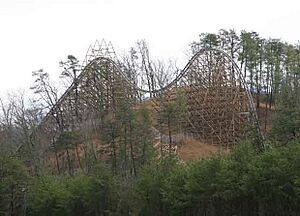
2018
- Wonder Woman Golden Lasso Coaster at Six Flags Fiesta Texas is the first single rail coaster.
- Steel Vengeance at Cedar Point is the first hyper-hybrid roller coaster.
2020s Milestones
2023
- Pipeline: The Surf Coaster at SeaWorld Orlando is the first surf coaster.
See also
- Roller coaster elements
- List of roller coaster rankings
- Physics of roller coasters
Images for kids


